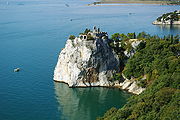
Duino
Encyclopedia

Adriatic Sea
The Adriatic Sea is a body of water separating the Italian Peninsula from the Balkan peninsula, and the system of the Apennine Mountains from that of the Dinaric Alps and adjacent ranges...
coast in the municipality (comune
Comune
In Italy, the comune is the basic administrative division, and may be properly approximated in casual speech by the English word township or municipality.-Importance and function:...
) of Duino-Aurisina
Duino-Aurisina
Duino-Aurisina is a comune in the Province of Trieste in the Italian region of Friuli-Venezia Giulia. Lying near the border with Slovenia, it has a substantial Slovene population...
, part of the region of Friuli – Venezia Giulia in the province of Trieste
Province of Trieste
The Province of Trieste is a province in the autonomous Friuli-Venezia Giulia region of Italy. Its capital is the city of Trieste.It has an area of 212 km², and a total population of 236,520...
, north-eastern Italy
Italy
Italy , officially the Italian Republic languages]] under the European Charter for Regional or Minority Languages. In each of these, Italy's official name is as follows:;;;;;;;;), is a unitary parliamentary republic in South-Central Europe. To the north it borders France, Switzerland, Austria and...
.
The total population is recorded as 8,753 (4,281 males, 4,472 females in 3,753 families), the population density (per square kilometre) as 193.8, and number of housing units as 3,983.
Duino is noted for being the place where the physicist Ludwig Boltzmann
Ludwig Boltzmann
Ludwig Eduard Boltzmann was an Austrian physicist famous for his founding contributions in the fields of statistical mechanics and statistical thermodynamics...
died and for inspiring the poet Rainer Maria Rilke
Rainer Maria Rilke
René Karl Wilhelm Johann Josef Maria Rilke , better known as Rainer Maria Rilke, was a Bohemian–Austrian poet. He is considered one of the most significant poets in the German language...
to write his Duino Elegies
Duino Elegies
The Duino Elegies are a set of ten elegies written in German by the poet Rainer Maria Rilke from 1912 to 1922. They are frequently referred to as Rilke's most acclaimed poetic work.-Presentation:...
. It is also the place where the famous Slovene folk legend Lepa Vida takes place.
The two castles
Duino castle
Duino castle is a castle in Duino, Italy overlooking the Gulf of Trieste.The castle dates back to 1389, when the Wallsee family commanded the construction of a strong fortress. Over time, the Wallsee family disappeared and the castle, after having been used as a prison, became the residence of the...
are the main attraction. The older castle, dating back to the eleventh century, is in ruins, while the newer castle is inhabited to this day and can be visited by tourists.
Below the ruins of the ancient castle there lies a white rock projecting into the sea, the Dama Bianca, which resembles a veiled woman and gave origin to many gothic legends.
Since 1982 the town has been home to the United World College of the Adriatic
United World College of the Adriatic
United World College of the Adriatic is a part of the United World Colleges, a global educational movement that brings together students from all over the world – selected on personal merit, irrespective of race, religion, politics and the ability to pay – with the explicit aim of fostering peace...
, an international school attended by students from 80 different countries.
Until the 1950s, Duino was a predominantly Slovene-speaking village with a sizeable Italian
Italian language
Italian is a Romance language spoken mainly in Europe: Italy, Switzerland, San Marino, Vatican City, by minorities in Malta, Monaco, Croatia, Slovenia, France, Libya, Eritrea, and Somalia, and by immigrant communities in the Americas and Australia...
-speaking minority. Before World War I
World War I
World War I , which was predominantly called the World War or the Great War from its occurrence until 1939, and the First World War or World War I thereafter, was a major war centred in Europe that began on 28 July 1914 and lasted until 11 November 1918...
, it used to be one of the centers of Slovene liberal nationalism in the County of Gorizia and Gradisca. During the years of the Free Territory of Trieste
Free Territory of Trieste
The Free Territory of Trieste was to be a city-state situated in Central Europe between northern Italy and Yugoslavia, created by the United Nations Security Council in the aftermath of World War II and provisionally administered by an appointed military governor commanding the peacekeeping United...
(1947–1954), however, its ethnic composition changed considerably, as many Istrian Italians
Istrian Italians
Istrian Italians are the ethnic group in the northern Adriatic region of Istria, related to the Italian people of Italy. Historically they are descendants from the original Latinized population of Roman Istria, from the Venetian-speaking settlers who came to Istria during the Republic of Venice,...
fleeing from Yugoslavia
Istrian exodus
The expression Istrian exodus or Istrian-Dalmatian exodus is used to indicate the departure of ethnic Italians from Istria, Rijeka, and Dalmatia , after World War II. At the time of the exodus, these territories were part of the SR Croatia and SR Slovenia , today they are parts of the Republics of...
settled in Duino. Nowadays, Duino is a predominantly Italian-speaking town, with a numerous Slovene-speaking minority. Most signs are written in both languages, and the municipality of Duino-Aurisina is an officially bilingual one.
Famous natives and residents include the Slovenian economist Ivan Ples (1886–1958), composer Andrej Volarič (1863–1895), and the Italian Jesuit philologist Gregorio Alasia de Sommaripa (1587–1626), who in 1601 compiled the first Italian-Slovene dictionary.

